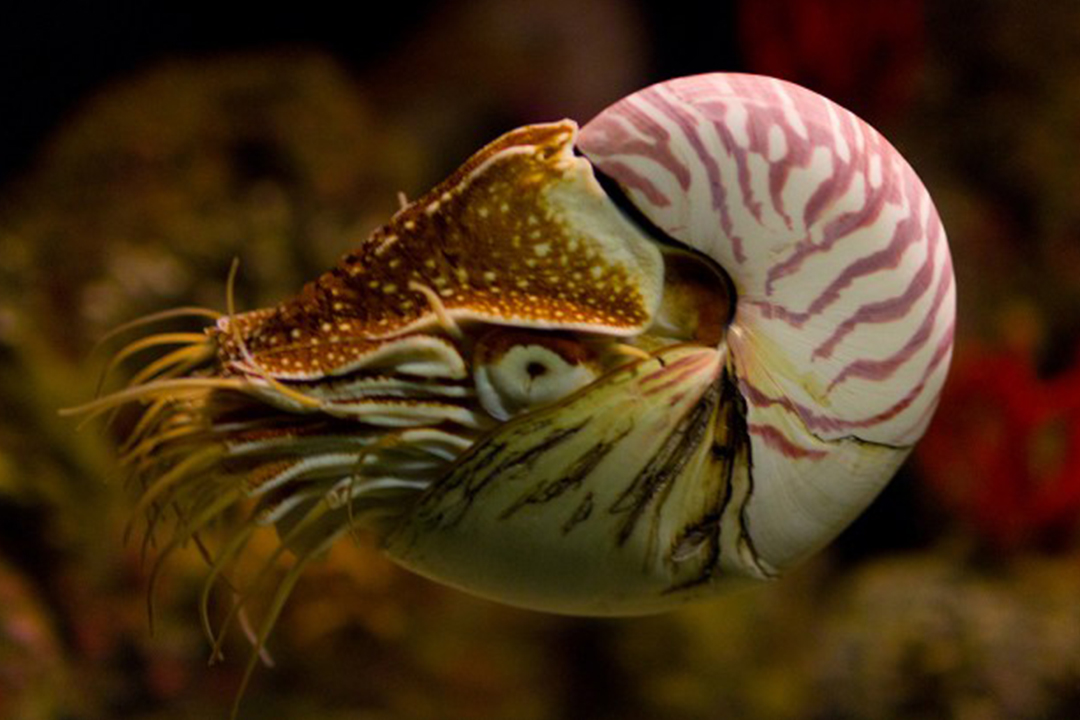By John DiConsiglio
For 500 million years, the nautilus has roamed the deep tropical waters of the Indio-Pacific Ocean region. With chocolaty-brown zebra stripes adorning its smooth white shell, the unassuming mollusk has seen the dinosaurs come and go. It has survived natural disasters from asteroids to earthquakes, and has adapted to shifts in the earth’s ecosystem and changes in the ocean’s chemistry.
So why are these so-called living fossils dying in zoos and aquariums around the world? What could possibly be killing a shell fish so resilient that it outlived the T-Rex?
That’s the mystery consuming Associate Professor of Forensic Sciences Mehdi Moini and a team of multi-disciplinary scientists gathered by the Smithsonian Institute. Studying captive mollusks from the National Zoo collection, Moini is part of a detective squad of chemists, pathologists and even museum curators who are hot on the killer’s trail. With the nautilus now on “the knife-edge” of extinction, as Moini puts it, cracking the case is crucial for studying everything from evolution to climate change.
“This is an animal that has remained virtually unchanged for millions of years. Studying the nautilus is like looking through a window into the planet’s evolution,” Moini said. “It’s a scientific goldmine.”
And while they haven’t quite cracked the case, Moini and the team have uncovered a significant clue. In a cover story in a recent edition of the prestigious peer review journal Zoo Biology, the group outlined evidence that could solve the mollusk mystery.
In the dark, cool water depth—nautilus can troll the sea floor at 2,000 feet—the animals have unusually long life spans of 15 years or more. But overfishing and the booming trade on their decorative shells has decimated the wild-nautilus population. Aquariums and zoos have become vital species-saving refuges and home to behavioral and developmental studies.
But nautilus in captivity tend to die within just two to three years, and researchers aren’t exactly sure why. In search of a solution, Moini and his team used an array of scientific equipment—from isotope ratio mass spectrometry (IRMS) to micro X-ray fluorescence (XRF) to the Forensic Department’s state-of-the-art proteomics instrument, the Thermo Orbitrap.
Once the nautilus is removed from its natural environment, a thick, roughhewed black substance develops on a portion of its smooth white shell. Examining samples from three nautiluses, Moini's team compared proteomics from the healthy portion of the shell with that of the disease portion that developed in captivity. When the scientists ran the samples through both the XRF and the IRMS, they found a severely tilted protein imbalance. The healthy white portions of the shells were routine. But the inky black areas were heavy with hemocyanin, a protein that leads to excess amounts of copper—a substance that can be harmful to shell formation. In addition, the discolored sections had lower levels of the “healthy” proteins.
“When I saw this, my eyes lit up. These levels shouldn’t be present,” he said. “Proteins are responsible for building the shell, so when we see that much copper, that’s alarming.”
The black shell streaks aren’t killing the nautilus, Moini believes. Instead, he said they act as a “biomarker”—a sign that something in the animal’s physiology has gone awry. “It’s like when a human takes his temperature,” he said. “It’s the nautilus’s way of telling us, ‘I'm not feeling good.’”
The team tried to follow the black-substance trail to the nautilus killer. But all the usual suspects had alibis. There were no traces of dangerous pathogens, like bacteria or viruses, in the samples. Factors like variations in the captive animal’s diet or tank-water chemistry were also quickly ruled out.
But that left a tantalizing possibility: stress. When a nautilus is removed from the wild and placed in captivity, it experiences environmental stress—from changes in pressure to shifts in temperature to new light patterns and oxygen levels. “Think about the stress they are subjected to: there’s the physical and chemical stress, the capture is stress, their new living environment is stress,” Moini said. He believes these stresses trigger a physiology change that reinforces the nautilus shell—hence the black deposits. Those same stress factors may be affecting the animals in a more lethal manner. “I'm sure there is some correspondent internally,” he noted.
More research is needed before a killer can be identified. But the clock may be ticking. Only 25 aquariums and zoos have been able to maintain nautilus collections, and only four have successfully bred them. In the wild, overfishing has slashed nautilus numbers by as much as 80 percent in once-rich areas like Australia’s Great Barrier Reef and the Philippines’ Bohol Strait. With virtually no international sanctions limiting the capture and trade of the nautilus, shells can sell for several hundred dollars. The U.S. alone imports 100,000 nautilus shells each year.
The loss of the nautilus could hinder scientific studies in everything from evolutionary trends to climate change effects on the oceans to human bone formation. “This is an animal with a remarkable capacity for survival,” Moini said. For the sake of science, Moini and his team are fighting to keep it that way.


